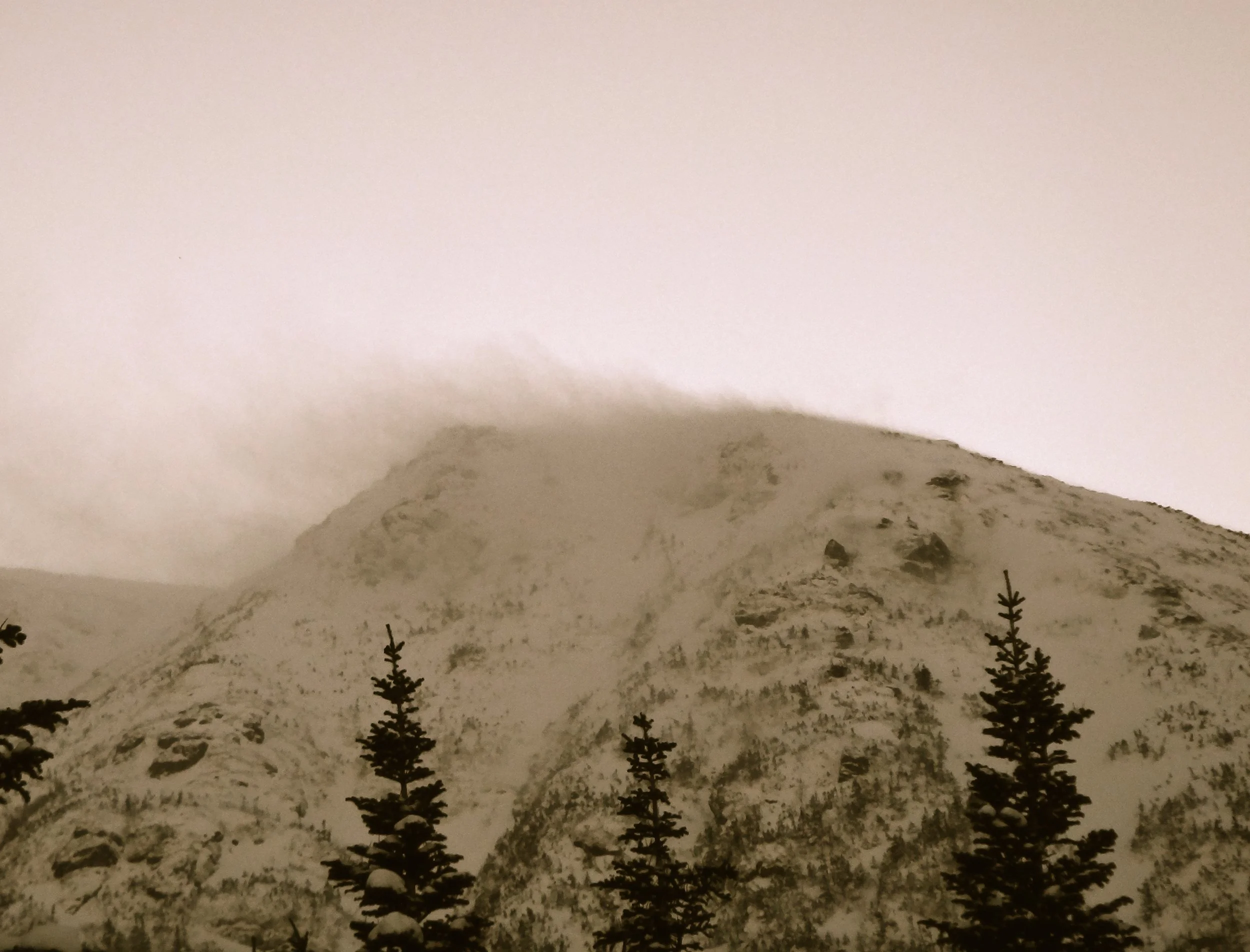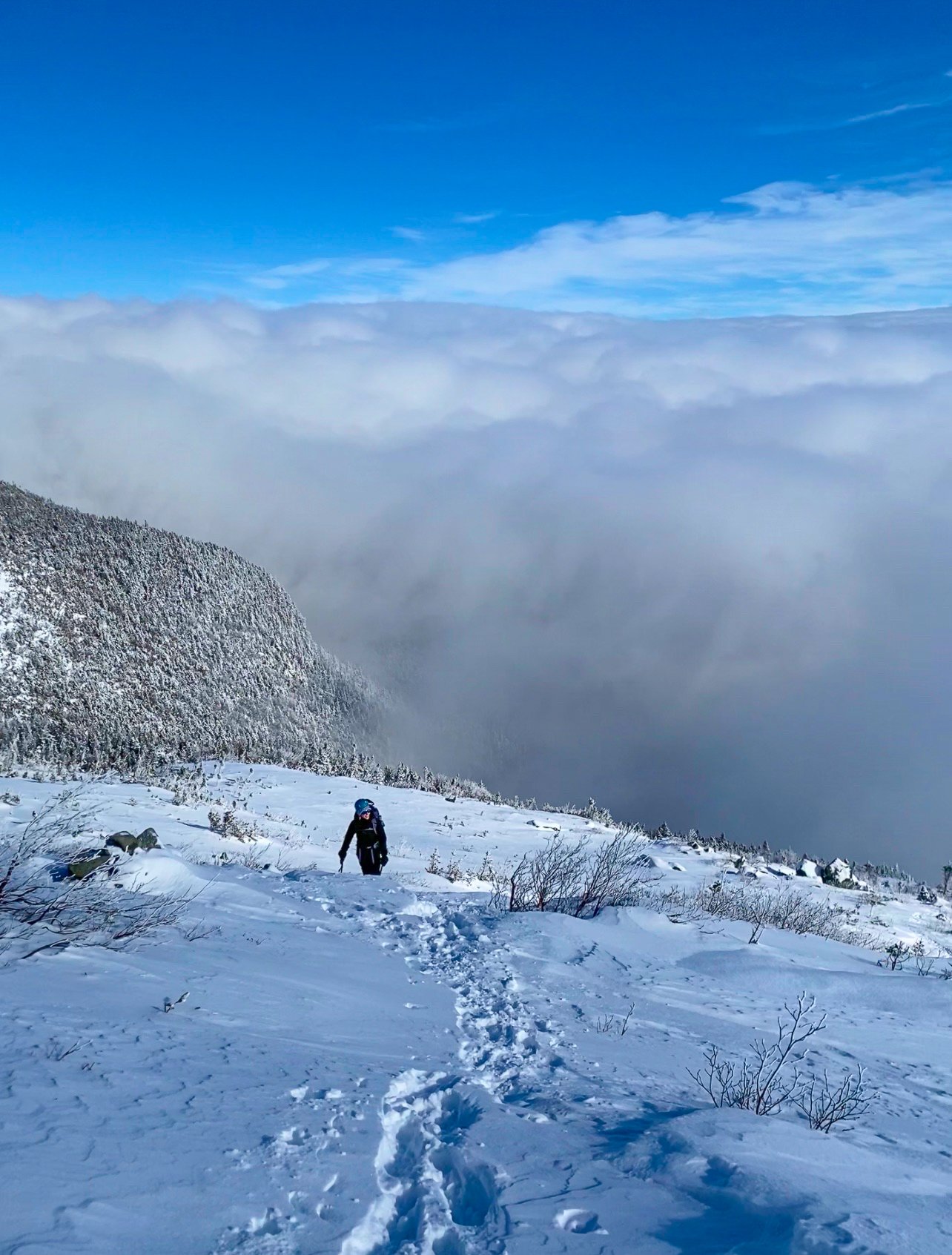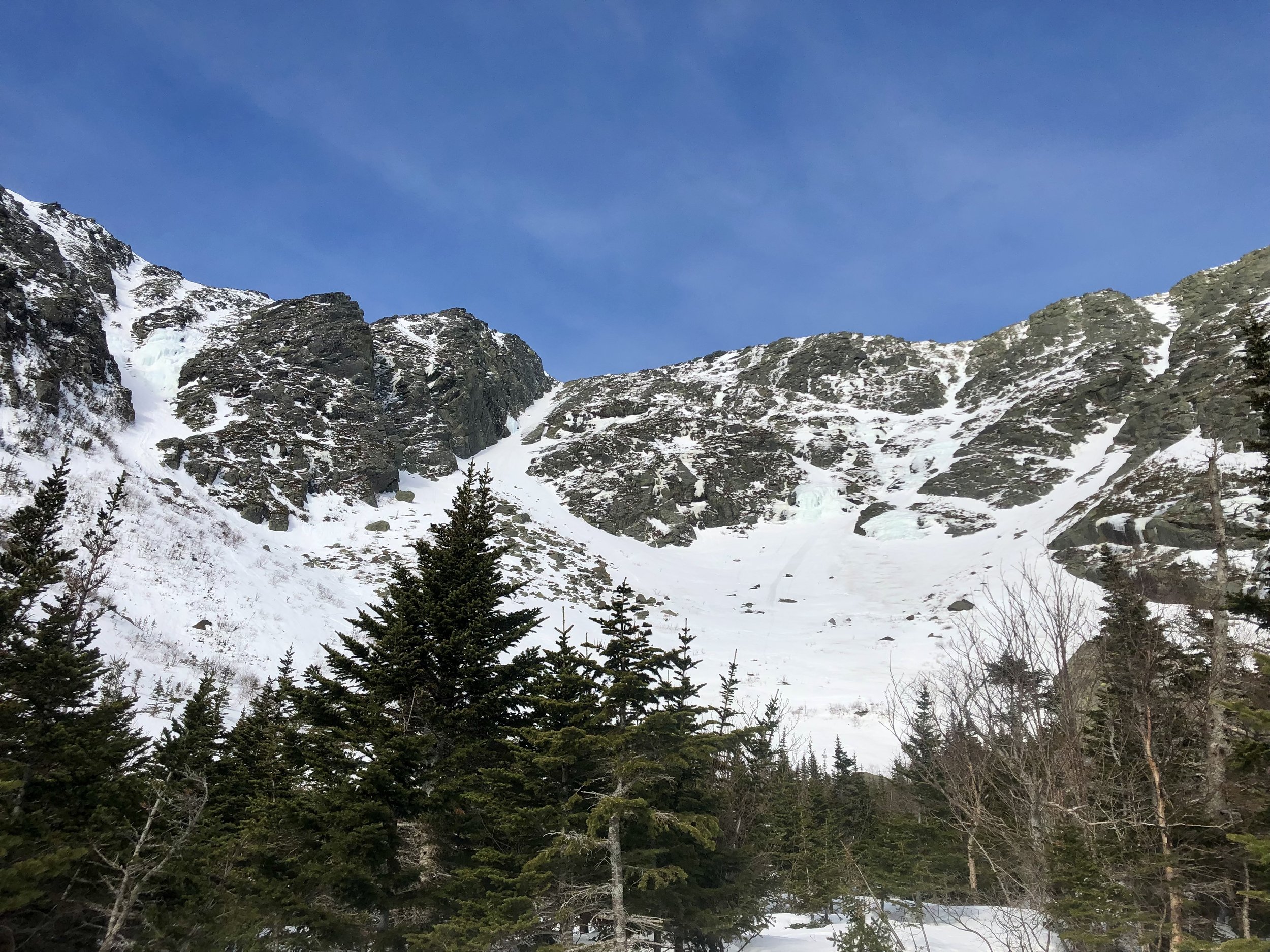
Mount Washington, NH
Difficulty
Beginner to Expert
Elevation Gain
3,900-4,275’
Duration
Full Days | Multi-day
Mileage
8-9 miles roundtrip
Summit Elevation
6,288’
Climbing Styles
Mountaineering | Alpine | Ski Mountaineering
Seasons
Winter through early Spring
Additional Info
Technical gear rental available
Offered at this location
Ice Climbing | Backcountry Skiing | Alpine Climbing | Avalanche Education
Mount Washington, NH - Unquestionably ‘the mountain’ of the east coast, Mt. Washington is considered to have some of the worlds worst weather, making it a feat to summit during the winter and one of the most sought after objectives in the North East. Winter ascents often occur from the east side of the mountain via the Winter Lion’s Head Route or through Tuckerman’s or Huntington Ravine or from the west side via the Ammonoosuc Ravine or Cog Railroad, providing options to fit a range of climbing backgrounds and technical proficiencies. A winter ascent is challenging and demands both physical and mental endurance.
Ammonoosuc Ravine and Cog Railroad
-
Climbing Mt. Washington’s west face via the Ammonoosuc Ravine or Cog Railroad is a great option if you don’t have prior experience with an ice axe and crampons and want to climb on Mt. Washington without completing a Mountain Skills Day. This route is also ideal for larger groups, as it does not require roped climbing. When weather conditions prevent summiting the west face also provides access to a summit attempt on Mt. Monroe, which is the 4th tallest mountain in the state.
Elevation Gain: 3,900’
Mileage: 8 miles roundtripItinerary
- 7:30am trailhead meetup
- Fit boots crampons and ice axes if necessary
- 8:00am depart trailhead
- 12:30-1:30pm begin descent
- 3:30-4:30pm return to trailheadWeather - Conditions frequently make or break summit attempts. We are unable to reschedule trips within 48 hours or provide refunds due to conditions that prevent travel above treeline. Your guide(s) will do everything possible to provide a valuable day regardless of the conditions. This may include the option of changing the day’s objective to ice climbing or skiing, or spending the afternoon working on more advanced mountaineering skills after climbing to a high point on the mountain.
-
Prior hiking experience and physical conditioning are needed to climb Mt. Washington in a day during winter on these routes.
Minimum Physical Ability:
- Comfortably ascend at a rate of 1000 vertical feet per hour.
- Comfortably hike 12 miles within 6 hours.
- Comfortably ascend and descend 4,500’ in elevation on foot, in one day. -
Required Equipment (not provided unless rented during the booking process):
Mountaineering boots: with a toe and heel welt for crampon compatibility. One pair per person. Single layer boots such as the Scarpa Mont Blanc are appropriate on a number of days. If you own a 1.5 layer boot, they are also a great option and provide extra warmth. On colder days, double boots such as the Scarpa Inverno may be necessary.
Crampons: strap on, semi, or fully automatic steel crampons are suitable for mountaineering. Vertical front points work but horizontal front points are preferable. One pair per person.
Ice Axe: One 50cm or longer ice axe per person.
If you need to rent equipment, and you didn’t during the booking process, contact us as soon as possible or arrange rental from a local outfitter.
You can bring your own mountaineering boots, crampons and ice axe if you prefer and they meet the above criteria.
Required Equipment (provided, but you can bring your own if you prefer):Helmet
Collapsable Trekking Pole
Micro-Spikes
Required Clothing (not provided): -
Gloves and mittens (multiple pairs are ideal: thinner gloves for hiking, thick gloves or mittens for climbing and above treeline. Three to five pairs of gloves is not unreasonable)
Winter socks - ski socks work great
Base layer - top and bottom
Fleece/synthetic/down mid layers
Soft or hard shell pants and jacket (note: it's common to tear pant legs with crampons)
Down/synthetic over-everything jacked (to be worn during breaks and above treeline)
Hat (consider fit under a helmet)
Balaclava/buff
Ski goggles (At least one pair. Two pairs can be beneficial.)
Sunglasses/glacier glasses appropriate for elevation and snow (must be wrap-around style or have side shields)
Other Required Items (not provided):Backpack for carrying personal items (including food, water, medication, additional winter clothing etc) and your mountaineering gear (helmet, ice axe, crampons etc) on the route. A pack between 30-45 liters is usually ideal.
Food (lunch, snacks, energy bars etc) and water.
Optional/Suggested items:
Sunscreen & lip balm
Sunglasses or ski goggles
Camera
Vacuum bottle/insulated water bottle
Trekking pole(s)
See your confirmation email for further details of what to bring.
Winter Lion’s Head Route
-
The Winter Lion’s Head Route is the most popular route to the summit of Mt. Washington during the winter. Beyond the rigors of the routes elevation gain and mileage the climb requires the use of crampons and ice axe and being prepared to be above treeline in the ‘the world’s worst weather’.
Elevation Gain: 4,275’
Mileage: 8 miles roundtrip
Itinerary (Summit Day)
- 7:30am trailhead meetup
- Fit boots crampons and ice axes if necessary
- 8:00am depart trailhead
- 12:30pm begin descent
- 3:30pm return to trailheadWeather - Conditions frequently make or break summit attempts. We are unable to reschedule trips within 48 hours or provide refunds due to conditions that prevent travel above treeline. Your guide(s) will do everything possible to provide a valuable day regardless of the conditions. This may include the option of changing the day’s objective to ice climbing or skiing, or spending the afternoon working on more advanced mountaineering skills after climbing to a high point on the mountain.
-
Prior technical experience and physical conditioning are needed to climb Mt. Washington in a day during winter. If you don’t have at least one day of prior experience using an ice axe and crampons, please book a Mountain Skills Day or day of Ice Climbing prior to a summit day.
Minimum Technical Proficiency:
- 1 day prior crampon and ice axe use.Minimum Physical Ability:
- Comfortably ascend at a rate of 1000 vertical feet per hour.
- Comfortably hike 12 miles within 6 hours.
- Comfortably ascend and descend 4,500’ in elevation on foot, in one day. -
Our Mountain Skills Day is designed to prepare you for a summit day on Mount Washington or other semi-technical mountaineering objectives. Completing this course will fulfill the technical skill prerequisites for a Summit Day on Mt. Washington.
This one day course covers:
- Equipment selection and packing
- Crampon and ice axe use and technique
- Roped snow climbing
- Mtn hazard management -
Required Equipment (not provided unless rented during the booking process):
Mountaineering boots: with a toe and heel welt for crampon compatibility. One pair per person. Single layer boots such as the Scarpa Mont Blanc are appropriate on a number of days. If you own a 1.5 layer boot, they are also a great option and provide extra warmth. On colder days, double boots such as the Scarpa Inverno may be necessary.
Crampons: strap on, semi, or fully automatic steel crampons are suitable for mountaineering. Vertical front points work but horizontal front points are preferable. One pair per person.
Ice Axe: One 50cm or longer ice axe per person.
If you need to rent equipment, and you didn’t during the booking process, contact us as soon as possible or arrange rental from a local outfitter.
You can bring your own mountaineering boots, crampons and ice axe if you prefer and they meet the above criteria.
Required Equipment (provided, but you can bring your own if you prefer):Helmet
Collapsable Trekking Pole
Micro-Spikes
Required Clothing (not provided): -
Gloves and mittens (multiple pairs are ideal: thinner gloves for hiking, thick gloves or mittens for climbing and above treeline. Three to five pairs of gloves is not unreasonable)
Winter socks - ski socks work great
Base layer - top and bottom
Fleece/synthetic/down mid layers
Soft or hard shell pants and jacket (note: it's common to tear pant legs with crampons)
Down/synthetic over-everything jacked (to be worn during breaks and above treeline)
Hat (consider fit under a helmet)
Balaclava/buff
Ski goggles (At least one pair. Two pairs can be beneficial.)
Sunglasses/glacier glasses appropriate for elevation and snow (must be wrap-around style or have side shields)
Other Required Items (not provided):
Backpack for carrying personal items (including food, water, medication, additional winter clothing etc) and your mountaineering gear (helmet, ice axe, crampons etc) on the route. A pack between 30-45 liters is usually ideal.
Food (lunch, snacks, energy bars etc) and water.
Optional/Suggested items:
Sunscreen & lip balm
Sunglasses or ski goggles
Camera
Vacuum bottle/insulated water bottle
Trekking pole(s)
See your confirmation email for further details of what to bring.
Huntington and Tuckerman Ravines
-
Technical alpine climbing during the winter and spring on Mt. Washington encompasses classic routes such as Pinnacle Gully, Damnation, and Odell’s. These routes entail snow, ice, and on some routes mixed climbing, along with milage on approach and descent. A technical alpine route on Mt. Washington is the ultimate test of mountain mobility and endurance.
Classic Routes:
- Pinnacle Gully III WI 3
- Right Gully Moderate Snow
- Damnation Gully WI 3 Steep Snow
- Odell’s Gully WI 3 Mod. Snow -
Minimum Technical Proficiency:
- Avalanche Rescue Course Completion OR Level 1 Course Completion OR a prior day that encompasses avalanche rescue practice.
- Prior lead belaying, rappelling, and multi-pitch following experience.
Minimum Physical Ability:
- Comfortably hike 12 miles within 6 hours.
- Comfortably ascend and descend 4,500’ in elevation on foot, in one day.
- Experience climbing at least the snow steepness or grade of ice or mixed terrain on the desired route. -
A note on equipment and packing: Alpine climbing is speed, energy, and equipment intensive. Carrying the minimal amount of highly functional equipment necessary for the objective can make or break a day. Ensure your gear is in good working order. Strive to leave behind anything that you don’t actually need. However, having a variety of equipment in your vehicle can provide options if the weather isn’t what you expected or a party is already on the planned route etc..
Required Equipment (not provided unless rented during the booking process):
Mountaineering boots: with a toe and heel welt for crampon compatibility. One pair per person. Routes above treeline often require a 1.5 layer boot for adequate warmth.
Crampons: semi or fully automatic steel crampons are best for technical ice and mixed climbing. Horizontal front points are appropriate for less technical routes like Shoestring Gully or snow climbs in Huntington or Tuckerman's Ravine. Vertical front points (or mono points) are preferable for routes with significant ice climbing, such as Pinnacle Gully or The Black Dike. One pair per person.
Ice Tools/Axe: One pair of technical (~50cm) ice tools per person are necessary for technical ice routes. For less technical routes a single 50cm or longer ice axe may be appropriate. Routes like Shoestring Gully may warrant an ice axe along with a single ice tool.
If you need to rent equipment, and you didn’t during the booking process, contact us as soon as possible or arrange rental from a local outfitter.
You can bring your own mountaineering boots, crampons and ice tools/axe if you prefer and they meet the above criteria.
Required Equipment (provided, but you can bring your own if you prefer):
Harness
Helmet
Micro-Spikes
Collapsable trekking pole (compact enough to fit inside your backpack)
Required Clothing (not provided):
Gloves and mittens (multiple pairs are ideal: thinner gloves for climbing, thick gloves or mittens for belaying. Three to five pairs of gloves is not unreasonable)
Winter socks - ski socks work great
Base layer - top and bottom
Fleece/synthetic/down mid layers
Soft or hard shell pants and jacket (note: it's common to tear pant legs with crampons)
Down/synthetic over-everything jacked (to be worn while not climbing and above treeline)
Hat (consider fit under a helmet)
Balaclava/buff
Other Required Items (not provided):
Backpack for carrying personal items (including food, water, medication, additional winter clothing etc) and your ice climbing gear (harness, helmet, ice tools etc) to the climbing area. For multi-pitch climbing, a pack between 25-45 liters is ideal to climb in.
Food (lunch, snacks, energy bars etc) and water
Optional/Suggested items:
Sunscreen & lip balm
Sunglasses or ski goggles
Camera
Vacuum bottle/insulated water bottle
Hand sanitizer
See your confirmation email for further details of what to bring.
In addition to climbing on Mt. Washington, the mountain is frequented for backcountry skiing and splitboarding. If you are interested in summiting ski mountaineering style and bagging the summit as well as a ski descent consider booking a day of backcountry skiing/riding.
Blue Ridge Mountain Guides, LLC is permitted by the White Mountains National Forest.













